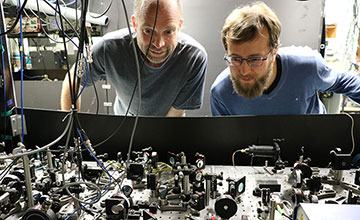
University of Otago researchers Mikkel Andersen (left) and Marvin Weyland in their physics lab. [Image: University of Otago]
Physicists in New Zealand have for the first time assembled groups of three atoms one by one. Using optical tweezers to bring individual cold atoms together and then set them colliding, they were able to tell how many atoms were lost when the trio subsequently broke up (Phys. Rev. Lett., doi: 10.1103/PhysRevLett.124.073401).
They found that the loss of all three atoms happened less than theory predicts.
Bottom-up approach
To try to understand atomic systems from the bottom up, researchers have in recent years made significant progress in isolating and manipulating single atoms. In particular, the tightly focused laser beams known as optical tweezers have allowed them to create molecules from individual atoms and to study inelastic collisions between atoms.
Even systems described from the top down—such as the large collections of particles sharing a single wavefunction known as Bose-Einstein condensates—are affected by interactions between individual atoms. In particular, particles can be lost via “three-body recombination.” This happens when three atoms get close enough to one another that two of them form a molecule and the binding energy released is enough to eject all three from the system.
Three-body recombination is known to take place in a wide variety of physical systems, on Earth and in space, but is difficult to model in detail. Mikkel Andersen at the University of Otago in Dunedin, New Zealand, says that while the process can be modeled fairly accurately under sufficiently simple conditions, it is harder to describe quantitatively in the relatively extreme environment of an optical tweezer.
It was to try and plug this gap that Andersen and colleagues at the University of Otago, working with researchers at Massey University in Auckland, New Zealand, carried out the latest research. In their paper, they say they have executed “the first controlled fabrication and manipulation of atom triads via a bottom-up approach of assembling atomic samples.”
Three atoms, three tweezers
To do so, the group isolated three atoms of rubidium-85 using three separate optical tweezers, spaced just over 4 micrometers apart. Using a frequency-shifting device known as an acoustic-optic modulator, the researchers then brought the centers of the three tweezers to within less than a micrometer of each other. Held in a merged, single beam, the atoms had a temperature of a little over ten millionths of a Kelvin above absolute zero.
Andersen and his co-workers then ramped up the beam power adiabatically, to squeeze the atoms closer together and make them collide faster while barely raising the temperature. They then used fluorescence to establish how many particles were left in the tweezer’s trap after a given collision duration.
To their surprise, the researchers discovered that most of the time a single atom remained. They established that, regardless of how long they left the atoms to vibrate, it was very rare that just one of the three would escape. But they also found that all three breaking loose—the case of three-body recombination—was relatively uncommon. Instead, two of the atoms tended to leak out. After two seconds with the beam at 170 mW, for example, that happened nearly 80% of the time.
Pushing current theory
The researchers say that the suppression of three-body recombination is “intriguing,” noting that it cannot be fully explained by current theory describing the behavior of bulk gases. They suggest that the apparent anomaly could be due to wave-function correlations caused by the particles’ spatial confinement and elastic scattering. But they add that additional theoretical work will be needed to verify this.
Andersen says that the research “pushes the boundaries for scientists’ ability to control and manipulate the microscopic world.” He adds that the molecules they assemble in optical tweezers might one day be used in quantum technologies, but says that at present any talk of applications is “pure speculation.”
